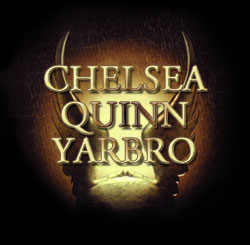
-
BlogCritics Interview
with Chelsea Quinn Yarbro, Author of the Saint-Germain Series by
Vyrdolak
22 May 2008"Cults and societies of were-creatures is a trope of late eighteenth-century shudder fiction, as the Germans, who came up with it, called it. Folklore almost always depicts were-creatures as being solitaries, and transforming either through religious ritual or exterior influences. For some, the transformation is totemic, for others, it is a sign of psychological difficulties. The archetypal function of these two figures is folklorically consistent: in western traditions, the vampire is a seducer and a sociopath, the were-creature is a rapist and psychotic."
-
MonsterLibrarian Interview with Chelsea Quinn Yarbro by Michele Lee
15 May 2008"I think of myself as a multi-genre writer: sometimes what I write sells in the horror market, sometimes in young adult, sometimes in science-fiction, sometimes in mystery, etc. etc. Given the reality of genre-defined publishing, I would be professionally remiss to ignore where my work sells, and who reads it. For the last decade, more than half my work has sold in the horror marketplace; it is very flattering that the readers think enough of my work to recognize it so well."
- Horror.
com: Chelsea Quinn Yarbro - Exclusive Interview by Staci Layne
Wilson
13 May 2006"Some academics credit Saint-Germain as the source of the rehabilitation of the vampire. I don't know that I agree, but I did deliberately push the Dracular version of vampires as far to the positive as I could and still have a recognizable vampire. I don't know why the readers keep coming back, but I'm delighted that they do."
-
Suite 101 Interview with Linda Suzane
12 Mar 2005"The Saint-Germain novels are called historical horror novels for a reason: history is horrifying. Compared to what people do to people, even a really hungry vampire is pretty small potatoes. I try to show the various periods as they saw themselves as much as I can, and to focus on the status and circumstances of women and the constraints of their societies. With those factors crucial to the nature of the story, quick reads are not really possible; it takes time to world-build, and to social-engineer. Context and environment function as tertiary characters in these stories even more than in the rest of my work, and as such, require explication beyond what I do in other genres."
- SciFi.Com
Interview with Christopher DeRose
Fall 2003
"Saint-Germain's first editor knew very little about vampire lore but what
little she
had seen in the movies, and it wasn't much, so she had no concerns about it to
speak of. Very
few editors worry about heresy,their goals are much too commercial, thank
goodness. Long before
[that first editor] saw Hotel Transylvania, back in 1971 when I was doing
my first work on the book,
I literally made a chart of worldwide vampire beliefs. Anything that 80 percent
of cultures
believed, I kept. The other 20 percent, if I liked it, I kept it; otherwise I
threw it out."
- Authors on the Web Horror Round Table Oct 2002 (Other participants include Suzy McKee Charnas, Geoffrey Huntington, Gregory Maguire, Michael Norman, Fred Saberhagen, and F. Paul Wilson)
- The Countess of Saint-Germain
by Denise Dumars (Cinescape)
8 Dec 2000 - Stealth Interview
Fall 2000
"I...don't think getting bitten in the neck is very erotic. You may notice I never say what it is {Saint-Germain] does, only that it feels really good when he does it. I would like to have him as a friend, though, if he existed outside my imagination. You'd be amazed at the number of his fans who think he actually does exist outside my imagination. It's a great compliment, but also a trifle unnerving."
-
Publishers Weekly: Chelsea Quinn Yarbro Makes the Move to E-Book
22 May 2000
"I'm a genre writer. People have been sneering for years--that's their business. People who read it, if they like it, won't care. If people insist on being bigoted, that's their problem."
- Library
Journal: E-Books: A Fantasy Come True? Chelsea Quinn Yarbro's
Magnificat
15 Apr 2000
"There are a lot of wonderful fantasies that sank like stones when they were first published in the 1970s and 1980s. With e-books, there's a chance to get these into the hands of readers who otherwise would have to spend a small fortune in the o.p. market."
"I came up with a semi-science fiction, semi horror story when I was four, and I've kept at it ever since."Mike Hodel's Hour 25 Interview
17 Nov 2000
"[Saint-Germain's] about 4000 years old. He was born about 2100 BC to Etruscan royalty in the Carpathians..."
"I think respect for the archetype and internal consistency of vision are probably the most important factors in dealing with any mythic characters. I grew up reading genre stuff, and anything else I could get my hands on! Dr. Seuss was once significant early influence and Lewis Carroll."
